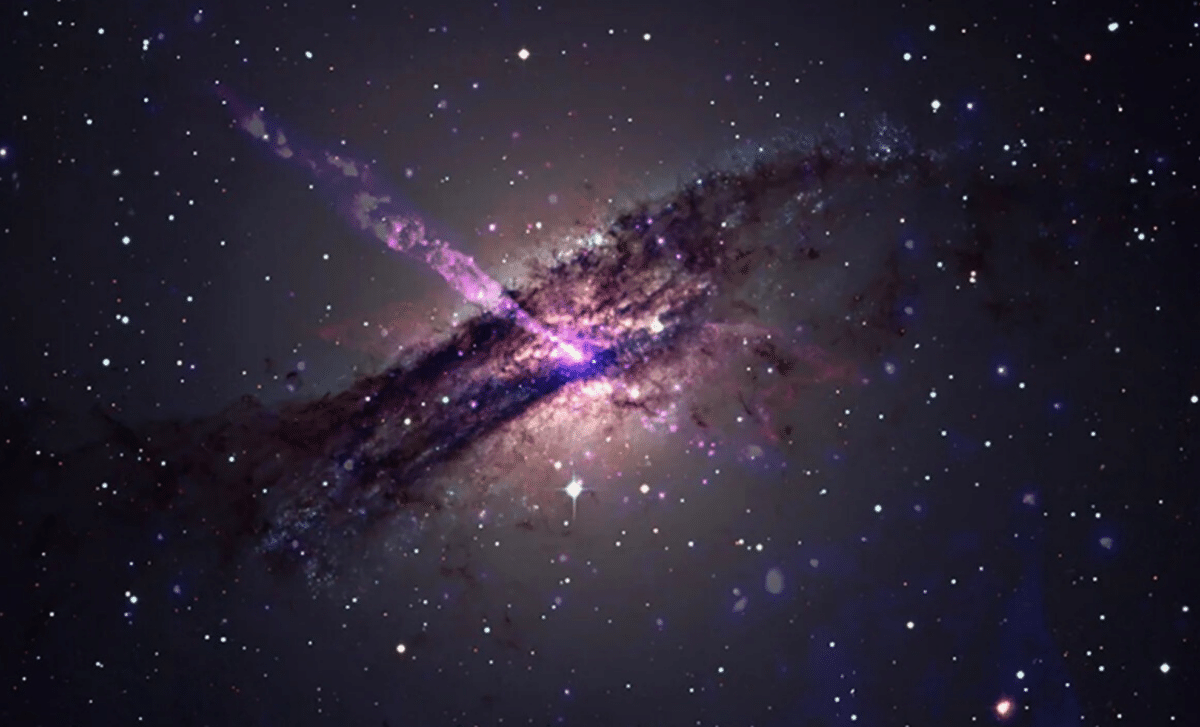
Arezki Amiri Published on December 16, 2024
Collected at: https://dailygalaxy.com/2024/12/a-black-hole-jet-collides-into-a-mysterious-object-whats-really-out-there/
A breakthrough discovery has recently rocked the world of astronomy: a jet of matter ejected from a massive black hole in the galaxy Centaurus A has hit an unknown object., creating a unique phenomenon in space. This collision left a V-shaped imprint in the X-rays observed by NASA’s Chandra X-ray Observatory. But what does this really mean?
The Black Hole Jet: A Destructive Force
At the heart of Centaurus A, a supermassive black hole ejects a jet of matter at nearly the speed of light. This jet travels thousands of light-years across space, carrying high-energy particles.
The black hole in question, with a mass of about 55 million times that of the Sun, is located 12 million light-years from Earth in a region of the universe known for its powerful jets and celestial collisions.
The Researchers Involved
The observations were made using NASA’s Chandra X-ray Observatory, which is capable of scanning the farthest reaches of the universe in the X-ray wavelength. The key researchers involved in this discovery include:
- Dr. Michael Wise, an astrophysicist at the Harvard-Smithsonian Center for Astrophysics (CfA), who supervised the observations.
- Dr. Joan Schmelz, an astrophysicist specializing in black hole jets and X-ray emissions, who contributed to the analysis of the data.
The Mysterious “C4” Object and the V-Formation
The collision between the jet and the object created a turbulent region that appeared as a V-shaped structure in the X-rays. This pattern is unprecedented and was described as a “never-before-seen” phenomenon by researchers. The exact cause of this V-formation is not fully understood, but the object in question, C4, is believed to be a massive star or perhaps an exotic object like a dark matter component.
“Never-Before-Seen” Phenomenon
According to Dr. Michael Wise:
“The V-shaped pattern has never been observed in such a collision. This phenomenon could be a key to understanding how black hole jets interact with unusual celestial objects.”

NASA/CXC/SAO/D. Bogensberger et al; Image Processing: NASA/CXC/SAO/N. Wolk;
C4: A Star or an Unknown Cosmic Phenomenon?
The object C4 appears to be a massive star, but scientists are not ruling out the possibility that it is something far more exotic, like a hidden compact object or a dark matter component. One of the more intriguing hypotheses is that C4 could be a stealthy companion object or even an invisible mass hidden in the galaxy.
The X-ray emissions produced by the collision indicate a massive release of energy, but the details of this emission raise more questions than answers. No other telescope has been able to capture this exact phenomenon, heightening interest in this observation.
Key Details About the Jet and Its Implications for Astronomy
- Black Hole Jet: This jet travels at 99% of the speed of light, ejecting particles over a span of 30,000 light-years. This jet is part of the energetic particle system associated with black holes, but researchers are now questioning whether this phenomenon plays a broader role in the dynamics of galaxies.
- X-ray Emissions: The collision generates a high-energy zone in space, with the density of gas and particles significantly increasing in the region.
- Centaurus A: The Centaurus A galaxy is one of the most studied in terms of its supermassive black hole and its extreme jets. This phenomenon has been observed from multiple angles using NASA’s Hubble Space Telescope and Chandra Observatory.
Additional Technical Details
| Element | Description |
|---|---|
| Object Hit (C4) | Likely a massive star or an unknown object whose exact nature remains unclear. |
| Black Hole Jet | Travels at 99% of the speed of light, ejecting particles across 30,000 light-years. |
| X-ray Emissions | The collision created intense X-ray emissions, the strongest ever observed at this location. |
| Observatory Used | Chandra X-ray Observatory, NASA’s flagship mission for observing X-rays. |
So, what should we make of this cosmic incident? While scientists have yet to determine the full implications of this collision, one thing is clear: the event challenges our understanding of black holes and their jets. As we probe deeper into the mysteries of Centaurus A and its surroundings, each new discovery adds layers of complexity to our view of the universe. What began as a routine observation of a well-known galaxy has now opened the door to a series of unknowns—each more tantalizing than the last.
The full study is recently published in The Astrophysical Journal.

Leave a Reply